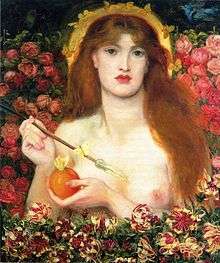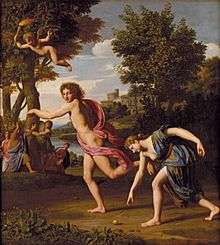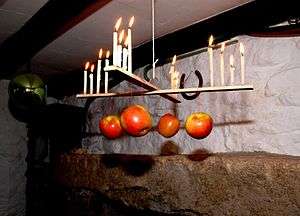Apple (symbolism)
Apples appear in many religious traditions, often as a mystical or forbidden fruit. One of the problems identifying apples in religion, mythology and folktales is that as late as the 17th century, the word "apple" was used as a generic term for all (foreign) fruit other than berries, but including nuts.[1] This term may even have extended to plant galls, as they were thought to be of plant origin (see oak apple). For instance, when tomatoes were introduced into Europe, they were called "love apples". In one Old English work, cucumbers are called eorþæppla (lit. "earth-apples'), just as in French, Dutch, Hebrew, Afrikaans, Persian and Swiss German as well as several other German dialects, the words for potatoes mean "earth-apples". In some languages, oranges are called "golden apples" or "Chinese apples". Datura is called "thorn-apple".

Ethnobotanical and ethnomycological scholars such as R. Gordon Wasson, Carl Ruck and Clark Heinrich write that the mythological apple is a symbolic substitution for the entheogenic Amanita muscaria (or fly agaric) mushroom. Its association with knowledge is an allusion to the revelatory states described by some shamans and users of psychedelic mushrooms.[2][3][4] At times artists would co-opt the apple, as well as other religious symbology, whether for ironic effect or as a stock element of symbolic vocabulary. Thus, secular art as well made use of the apple as symbol of love and sexuality. It is often an attribute associated with Venus who is shown holding it.
Mythology and religion
_2.jpg)
Though the forbidden fruit in the Book of Genesis is not identified, popular Christian tradition holds that Adam and Eve ate an apple from the forbidden tree in the Garden of Eden. The unnamed fruit of Eden thus became an apple under the influence of the story of the golden apples in the Garden of Hesperides. As a result, the apple became a symbol for knowledge, immortality, temptation, the fall of man and sin.
The classical Greek word μήλον (mēlon), or dialectal μᾶλον (mālon), now a loanword in English as melon, meant tree fruit in general,[5] but was borrowed into Latin as mālum, meaning 'apple'. The similarity of this word to Latin mălum, meaning 'evil', may also have influenced the apple's becoming interpreted as the biblical "forbidden fruit" in the commonly used Latin translation called "Vulgate". The larynx in the human throat has been called Adam's apple because of the folk tale that the bulge was caused by the forbidden fruit sticking in the throat of Adam. The apple as symbol of sexual seduction has sometimes been used to imply sexuality between men, possibly in an ironic vein.

The notion of the apple as a symbol of sin is reflected in artistic renderings of the fall from Eden. When held in Adam's hand, the apple symbolises sin. But, when Christ is portrayed holding an apple, he represents the Second Adam who brings life. This difference reflects the evolution of the symbol in Christianity. In the Old Testament, the apple was significant of the fall of man; in the New Testament, it is an emblem of the redemption from that fall. The apple is represented in pictures of the Madonna and Infant Jesus as another sign of that redemption.
In some versions (such as Young's Literal Translation) of the Bible, the Hebrew word for mandrakes dudaim (Genesis 30:14) is translated as "love apples" (not to be confused with the New World tomatoes). There are several instances in the Old Testament where the apple is used in a more favourable light. The phrase 'the apple of your eye' comes from verses in Deuteronomy 32:10, Psalm 17:8 Proverbs 7:2, and Zechariah 2:8, implying an object or person who is greatly valued. In Proverbs 25:11, the verse states, "a word fitly spoken is like apples of gold in settings of silver". In the love songs of the Song of Solomon, the apple is used in a sensual context. In these latter instances, the apple is used as a symbol for beauty. The apple appears again in Joel 1:12 in a verse with a sense of profound loss when the apple tree withers. During the Jewish New Year - Rosh Hashanah - it is customary to eat apples dipped in honey to evoke a "new year that is good [the apple] and sweet [the honey]".
Greek

The Greek hero Heracles, as a part of his Twelve Labours, was required to travel to the Garden of the Hesperides and pick the golden apples off the Tree of Life growing at its center.
Atalanta, also of Greek mythology, raced all her suitors in an attempt to avoid marriage. She outran all but Hippomenes (a.k.a. Melanion, a name possibly derived from melon the Greek word for both "apple" and fruit in general), who defeated her by cunning, not speed. Hippomenes knew that he could not win in a fair race, so he used three golden apples (gifts of Aphrodite, the goddess of love) to distract Atalanta. It took all three apples and all of his speed, but Hippomenes was finally successful, winning the race and Atalanta's hand.
The Greek goddess of discord, Eris, became disgruntled after she was excluded from the wedding of Peleus and Thetis. In retaliation, she tossed a golden apple inscribed Kallisti ('For the most beautiful one'), into the wedding party. Three goddesses claimed the apple: Hera, Athena, and Aphrodite. Paris of Troy was appointed to select the recipient. After being bribed by both Hera and Athena, Aphrodite tempted him with the most beautiful woman in the world, Helen of Sparta. He awarded the apple to Aphrodite, thus indirectly causing the Trojan War.
Norse
In Norse mythology, the goddess Iðunn is strongly associated with apples. Iðunn was abducted by Þjazi the giant, who used Loki to lure Iðunn and her apples out of Ásgarðr. After borrowing Freyja's falcon skin, Loki liberated Iðunn from Þjazi by transforming her into a nut for the flight back. Þjazi gave chase in the form of an eagle, whereupon reaching Ásgarðr he was set aflame by a bonfire lit by the Æsir.
Celtic

Allantide (Cornish: Kalan Gwav, meaning first day of winter) is a Cornish festival that was traditionally celebrated on the night of 31 October, as well as the following day time. One of the most important parts of this festival was the giving of Allan apples, large glossy red apples that were highly polished, to family and friends as tokens of good luck. Allan apple markets used to be held throughout West Cornwall in the run up to the feast. and in the town of St Just it surpassed Christmas as a time for giving gifts until the late 20th century. A game was also recorded in which two pieces of wood were nailed together in the shape of a cross. It was then suspended, with 4 lit candles on each arm and Allan apples suspended underneath. The aim being to catch the apples with your mouth without getting molten wax on your face. For unmarried recipients the apples would be placed under their pillows in the hope that they would bring dreams of their future wife or husband.[6]
Legends, folklore, and traditions
- In North America a Native American is called an "apple" (a slur that stands for someone who is "red on the outside, white on the inside.") primarily by other Native Americans to indicate someone who has lost touch with their cultural identity. First used in the 1980s.[7]
- Savior of the Apple Feast Day is celebrated on August 19 in Russia and Ukraine.
- A boatbuilder's superstition holds that it is unlucky to build a boat out of wood from an apple tree because this wood was previously used to manufacture coffins.[8]
- Since 1990, Apple Day has been held across the UK and beyond, on October 21. This is a festival created by charity Common Ground to support localism: folksongs, biodiversity, buried orchards, children's games.
- Irish folklore claims that if an apple is peeled into one continuous ribbon and thrown behind a woman's shoulder, it will land in the shape of the future husband's initials.
- A popular folk art involves a process to turn apples into wrinkly representations of human heads, usually be placed on dolls.[9] In 1975, Vincent Price promoted a horror-themed kit that used a similar process to create faux shrunken heads, Shrunken Head Apple Sculpture, by Whiting Crafts.
- In some places, apple bobbing is a traditional Halloween activity.[10]
- During the Jewish New Year - [Rosh Hashanah] - it is customary to eat apples dipped in honey to evoke a "sweet new year".
- In the United States, Denmark and Sweden, a fresh, polished apple was a traditional children's gift for a teacher, starting in the 19th century. The symbol of an apple is still strongly associated with teachers to this day, with apples being a popular theme for gifts and awards given to exemplary teachers.
- The Apple Wassail is a traditional form of wassailing practiced in cider orchards of South West England during the winter. The ceremony is said to 'bless' the apple trees to produce a good crop in the forthcoming season.
- "Comparing apples and oranges" means to examine the similarities of things that are completely different; in German and Dutch the corresponding expression is "comparing apples with pears".
- "An apple a day keeps the doctor away" is a popular saying, the apple obviously symbolizing health, but also the advantages of eating fresh fruit.
- Johnny Appleseed is said to have wandered the early United States planting apple trees by leaving seeds wherever he went.
- The design concept for the Design and Arts Arcadia of Myungseung, located in Chuncheon, Korea, is based on an apple with the top-third and the bottom-third sliced off while having the skin peeled around the circumference.'
- In Kazakhstan, the ex-capital city's name "Almaty" derives from the Kazakh word for 'apple' (алма), and thus is often translated as "full of apples;" alma is also 'apple' in other Turkic languages, as well as in Hungarian.
- When Eris tossed the Golden Apple of Discord into the feast of the gods at the wedding of Peleus and Thetis, at least in historic literary terms, the reference to 'apple' would more likely have been an extinct species of the Balkans similar to the pomegranate.
 Venus Holding an Apple, Daniel Mauch
Venus Holding an Apple, Daniel Mauch The Virgin and Child Under an Apple Tree, Lucas Cranach the elder
The Virgin and Child Under an Apple Tree, Lucas Cranach the elder Two Young Men,
Two Young Men,
Crispin van den Broeck (Dutch), ca. 1590; Oil on panel; Fitzwilliam Museum, Cambridge.
See also
References
- Douglas Harper, Historian (25 May 2011). "apple". Online Etymology Dictionary.
- Wasson, R. Gordon (1968). Soma: Divine Mushroom of Immortality. ISBN 0-15-683800-1.
- Ruck, Carl; Blaise Daniel Staples; Clark Heinrich (2001). The Apples of Apollo, Pagan and Christian Mysteries of the Eucharist. Durham: Carolina Academic Press. pp. 64–70. ISBN 0-89089-924-X.
- Heinrich, Clark (2002). Magic Mushrooms in Religion and Alchemy. Rochester: Park Street Press. pp. 64–70. ISBN 0-89281-997-9.
- Entry μῆλον at Liddell & Scott.
- Simon Reed - The Cornish Traditional Year 2009
- Green, 2005, ISBN 0-304-36636-6, p. 29
- Eyers, Jonathan (2011). Don't Shoot the Albatross!: Nautical Myths and Superstitions. A&C Black, London, UK. ISBN 978-1-4081-3131-2.
- How to make apple dolls, purchase dolls, witches- instructions by Pamela Matson
- "Halloween 2015".